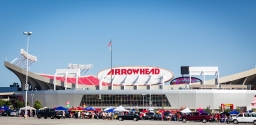Arrowhead Stadium
Arrowhead Stadium, more commonly known as GEHA Field at Arrowhead Stadium, has become the iconic representation of American football stadiums. Located in Kansas City, Missouri, the stadium has been home to the Kansas City Chiefs since the team’s inception in 1972. Having a total occupancy of 76,416, it ranks fifth in size among all NFL teams. Arrowhead is associated with high-stakes football, die-hard fans, and the boundless spirit inherent in the Kansas City tradition. [1]
The Birth of Arrowhead Stadium
The process of developing the facility that resulted in Arrowhead Stadium started in the mid-1960s after the Kansas City Chiefs relocated from Dallas and dropped the name Dallas Texans. Old Municipal Stadium was used by all of Kansas City’s baseball teams first, and this eventually prompted the need for an exclusive football field. This created the Jackson County Sports Complex Authority, which undertook the construction of the stadium.
Work on the Arrowhead Stadium was started on July 11, 1968, during the construction of two stadiums for the Royals and the Athletics teams. Built specifically for football, it took four years to construct Arrowhead and was thrown open to the public on August 12, 1972. [2]
Design and Architectural Innovation
Architect Charles Deaton’s unique vision was evident in this new Arrowhead Stadium as well. Unlike the majority of multi-purpose facilities that were constructed in the 1970s, Arrowhead was designed strictly with football in mind so the fans could see the game in its entirety. Its spectacular bowl design with more than 79 thousand red and gold seats arranged at three levels became instantly recognizable.
The early architectural plan called for a rolling roof specifically over the Arrowhead as well as the adjacent Royals Stadium. But this splendid feature was never implemented essentially because of the strain of costs. Without the roof, Arrowhead remained an engineering and design musical marvel, as well as providing an even more intimate look at the game.
Renovations and Modernization
To continue with its prestige, Arrowhead Stadium has undergone some changes, including Campbell’s stadium, which underwent a major facelift in 2010 where the stadium was brought to a modern standard while retaining its historical nature. New developments arrived with the 5 million investment in the renovation financed by taxpayers and a contribution by the Hunt family, the Chiefs’ owners.
Additional features were greater concourse areas, improved seating, the synthesis of luxury boxes, new lavatories, and concession places. Bridges were constructively overlaid; the pattern of the stadium’s concrete framework was revived; and improved multimedia screens were added.
Beyond Football: A Multi-Event Venue
Arrowhead Stadium may be home to the Kansas City Chiefs, but that is not the only use that this stadium can be put to. These have included annual celebrations and major concerts involving singers such as U2, Taylor Swift, and Garth Brooks, among others. It has also hosted college football games and international soccer matches, which has further enhanced its appeal to many people.
Arrowhead has even dropped the pop culture references on occasion. The building has been used in commercials and TV shows as well as documentaries, thus becoming a symbol of cultural importance. The ability of the stadium to host other events from time to time guarantees that it has a calendar year of activities attracting different crowds. [3]
Sustainability and Community Impact
Arrowhead Stadium is not only a football ground for sports but also a provision for the people of Kansas City. Contemporary changes in the building reflect sustainability and accessibility concerns, as have been made in recent years. Modern energy-saving installations, barrier-free access for the disabled, and environmentally sustainable practices define its progressive outlook.
The Chiefs’ organization, in cooperation with Arrowhead, is actively involved with the community, works with youths, and has numerous activities related to charity. All these efforts have helped cement the relationship between the stadium and the city, making Arrowhead much more than a venue to watch football; it is part and parcel of the city’s pride.
Challenges and the Road Ahead
With preemptions on the flowing future of the NFL, these debates on the possible future of Arrowhead Stadium have been given momentum. The current lease in the stadium is to end in 2030, and this makes there be discussions on whether the Chiefs should make further renovations or build a new home. While Arrowhead has the longest history and is beloved by fans, it wouldn’t be a surprise to see teams such as SoFi Stadium and Allegiant Stadium, which have modern facilities that could influence the Chiefs.
As the NFL changes, planning regarding the future of the stadium has emerged as an area of discussion. The current lease in the stadium is to end in 2030, and this makes there be discussions on whether the Chiefs should make further renovations or build a new home.
A Legacy Built on Passion
Arrowhead Street is traditionally loved because it preserves the traditional aesthetic of the games and at the same time is a relatively contemporary venue. Arrowhead had its beginning of design in the 1970s and now has become one of the loudest stadiums in the NFL, and fans and players alike love going there. Moreover, its history should be connected with the Kansas City Chiefs, the team that has climbed to the top of the NFL.
Conclusion
Arrowhead Stadium is not just a place for athletic events; it also holds greater significance for custom, community, and unity. Beyond the pitch, this revelation spreads among Kansas City citizens and spectators. It is one of the NFL's most iconic stadiums and has witnessed just as many exciting events as it will probably continue to be a site of accomplishments.
Images
Related-topics
References
- Visit Kansas City [ Geha Field at Arrowhead Stadium ] January 23, 2025
- Stadiums of Pro Football [ Arrowhead Stadium ] January 23, 2025
- Kansas City Chiefs [ Arrowhead Stadium ] January 23, 2025
Contributors
Last Modified: June 27, 2025
